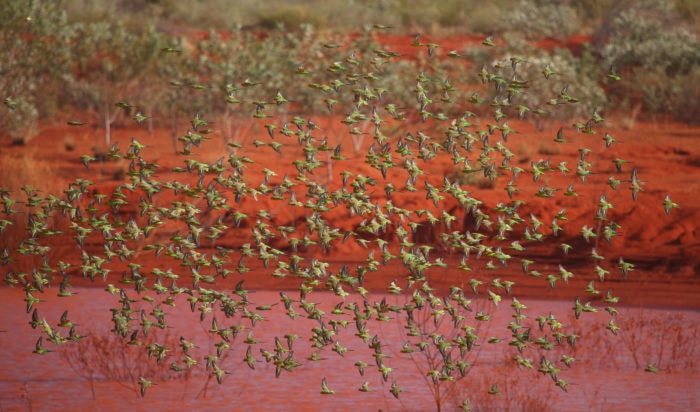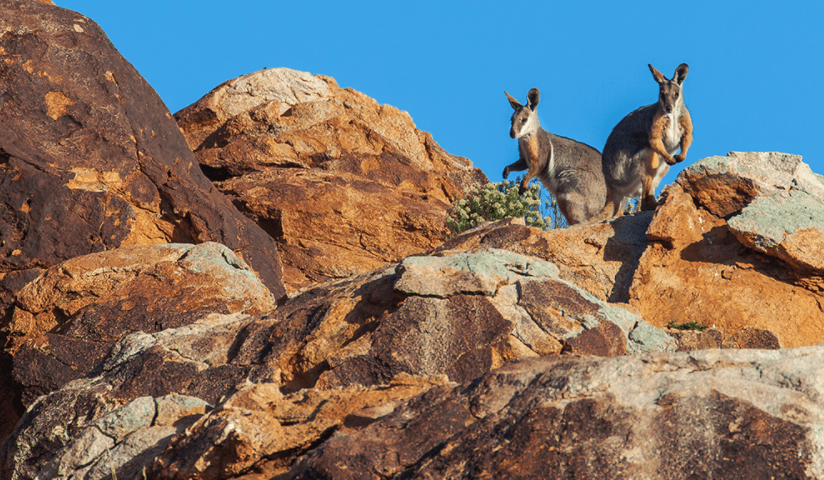It’s a bird’s life in Outback NSW

IT’S 5.45AM ON a late spring day and I’m fighting the rising sun for a few more hours of shut eye. Tucked under an old eucalypt in outback NSW, a few hours drive north east from the iconic Aussie town of Broken Hill, I’m enjoying the cosy hug of my hammock. I’d been up half the night gazing into the star-spangled blanket of inky sky, and now desperately want to keep snoozing. But the eager sun and a cacophony of birds have other ideas.
I’ve come to Mutawintji National Park to range around its rugged gorges and waterholes, and hopefully meet some of its plentiful wildlife – from burly, bold red ‘roos and flighty emus, to chattering flocks of budgerigars and zebra finches.
I don’t need to open my eyes to know a party of budgies has alighted in a tree not too far from me – they’re busy with their morning banter.
“The most animated, cheerful little creatures you can possibly imagine”,
is how John Gould, ornithologist and bird artist, described these birds in the 1800s.
I lie there, ears filled with the sounds of these bright yellow and green avian delights, imagining just what their conversations entail… “Good sleep, Merv?” asks one, to which another replies, “Not bad Harry, but the bloody chicks kept me awake well past midnight.” I chuckle to myself.

And then I hear another character join the conversation. Its squark is as distinctive as its feathers are white; it’s the short-billed corella. There’s a handful of the noisy buggers, squabbling over something… and prising my eyes open I discover it looks like a piece of bush fruit.
The sky’s now an exquisite expanse of apricot and gold, and I roll out of my hammock, scaring off a blue-cheeked bird grazing on insects and seeds on the nearby ground. Given its grey body and the black scalloping on its wings, I hazard a guess that its an apostlebird. And if I know anything about this little creature it’s that if there’s one, there’s more in the immediate vicinity. They’re all about family, so much so that they feed together, gather nesting materials together, and hang out in trees together looking super snug.

It’s not even 7am and I’ve already spotted three of the birds on my list. I wonder if I need to get up at all. If I just hang out in my hammock for the day, quietly swaying in the breeze, perhaps even more of Mutawintji’s winged jewels will reveal themselves. Like the predatory wedge-tailed eagle or peregrine falcon, which swoops on its prey at speeds of up to 300km/h (although I suspect I’ll need to go cliff hunting for the latter). As for the fluttery orange-beaked zebra finch, I plan to head to one of the nearby waterholes to spy this little gem en masse (they live year round in social flocks of up to 100 or more birds in and around grasslands and water courses).

But rise I have and after a quick brekky I’m off to explore the rocky ridges of the park to hopefully spot a member of the only NSW colony of the endangered yellow-footed rock wallaby. The largest of the rock-wallabies, it is Australia’s most brightly coloured mammal. Beautifully marked and coy by nature, they’re a marvel in motion, hopping across their cliff-face hideouts.
I wander along the breathtaking Homestead Gorge walking track, epic scenes of red-rock gorges and ancient Aboriginal engravings laid out before me. The traditional home of the Malyankapa and Pandjikali people, Mutawintji NP has been a significant meeting place for local cultures for thousands of years. Communities have performed initiations, rainmaking and other ceremonies here in gatherings of up to 1000 people. You’ll find paintings, stencils and engravings that depict pre- and post-colonial Aboriginal history in the park, as well as the animals that live in the area, including kangaroos and emus.
I marvel at the paintings and wonder whether these animals roamed the saltbush and mulga plains, which stretch to the horizon here, in far greater numbers before European settlement.
I have no luck spotting yellow-footed rock-wallabies, and so return to camp for lunch and a mid afternoon relax before heading out along the Mutawintji Gorge walking track. In the late afternoon I happen across blue-tongue lizards basking in the sun and stop to use the macro setting on my camera to capture the brilliance of one of Australia’s most famous desert wildflowers, the Sturt’s desert pea. Found across inland arid regions of Australia, it thrives in red sandy soil and has vibrant red leaf-shaped flowers with a black centre, known as a ‘boss’.

As the light begins to fade I head back towards camp keeping an eye on the rocks above and, before long, furry shapes appear, scooting among the ledges and crevices. One moment they’re hopping up steep faces. The next, a pair is jumping a crevasse-like gap with ease. More than acrobatic, it’s a sheer marvel.

That night, tucked up in my hammock once again beneath a comforting blanket of stars, I can’t quite believe my luck – so many wildlife encounters in just one day.
But that’s the beauty of Mutawintji, and moreover Outback NSW, there’s plenty to marvel over and, seemingly, all the space in the world in which to do it.
Other wildlife watching hotspots in Outback NSW

Paroo-Darling National Park
The Paroo Overflow and its associated wetlands sustain a unique ecosystem, including such threatened species as the freckled duck and blue-billed duck. You may also see black-breasted buzzards, pink cockatoos, pied honeyeaters and any one of 55 bird species that visit the lakes. Peery Lake, a major part of the system, is part of an internationally significant wetland and protected under the Ramsar Convention.
Visit Paroo-Darling NP for more information.

Kinchega National Park
Kinchega is the traditional land of the Paakantji nation, a river people who caught fish by spearing from a canoe or while diving and used nets and fish traps made from baskets. Artefacts and special sites in the area date back 35,000 years. Meander along the Darling River’s red gum-lined banks, which mark the park’s eastern boundary, or stroll the shores of Lake Menindee, Lake Cawndilla and Lake Emu. It’s a dry landscape that bursts with seasonal wildflowers after rain. Abundant wildlife – birds, kangaroos, goannas and emus – bring opportunities for photography. Kinchega is just 100km south of Broken Hill, near the township of Menindee.
Visit Kinchega NP for more information.

Sturt National Park
The ephemeral Lake Pinaroo was classed as a Ramsar wetland area in 1996 and is the largest terminal basin in this area of NSW (4 hours drive north of Broken Hill). It plays a crucial role in the survival of many plants and animal species, and supports large numbers of waterbirds and waders, including international migratory species and threatened species. When full, Lake Pinaroo is a stunning contrast to the dry landscapes of Sturt NP. You can see waterbirds such as freckled and blue-billed ducks, and large flocks of unique desert birds such as the budgerigar.
Visit Sturt NP for more information.
To discover more about Outback NSW, head to Visit NSW today.

